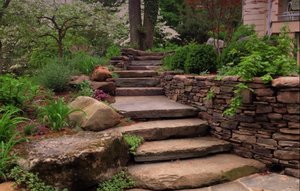Six Essentials of Step Design
Steps can be formal, orderly and symmetrical in nature. They can come in elegant pairs, curving up left and right to reach a terrace with a stone balustrade. Or steps can be informal, nothing more than a series of stepping stones, weathered logs or grass treads that almost disappear into the landscape.
They can also be focal points, decorative features fitted out with statues, urns or even water running alongside. You may even design a fountain in the middle of them. The only firm rule about step design is that the materials need to complement the house, as well as any nearby or adjacent walkways and retaining walls that are within eyesight.
1. Calculate the ratio of risers to treads.
In indoor spaces, most steps have risers that are between four and seven inches high. Treads are generally twelve inches deep. Outdoors, you’ll want to keep to this formula if your stairway is in a well-traveled spot. The last thing you want to do while carrying groceries is worry about watching your feet. Generally, the risers of exterior steps are six inches in height and the treads are sixteen inches deep.
In outdoor areas where traffic is more leisurely, the measurements of both risers and treads can be altered to slow or speed up the pace of travel. Low risers and wide treads generally encourage faster steps. But when low risers are accompanied by treads that require two or more paces to cross, they slow down the pace of progress, making visitors pay more attention to the surroundings.
2. Calculate the number of steps.
No one wants to be embarrassingly out of breath at any point of a garden stroll. A good stairway has anywhere from three to twelve steps. One or two lone steps are hard to see and possibly hazardous. More than twelve steps are hard to scale without a place to stop and breathe.
If you’re faced with a long flight of steps, break it up with landings. On a steep grade, landings should come every three to eleven steps. Landings can either be functional places to pause or small terraces with seats and plantings.
3. Calculate the width of your steps.
For a short climb, narrow steps are not a problem. But in most instances, steps should be at least four feet wide so that one person can be going up and another down without rubbing shoulders. The wider the steps, the more they become a place to stop, sit and enjoy the surroundings. When steps become wide enough for lounging, they cease to be merely functional and become a garden feature as well.
4. Decide on the course of your steps.
Straight, curved or zigzag? The course should be dictated by the style and mood of your garden. Curved and zigzagging steps require a deliberate pace; it is hard to sprint up or down them. Straight steps are generally more functional and formal.
Steps that angle away from the path convey the feeling that you’re taking a journey. Consider curving your steps around trees and planting beds to vary the view and add suspense to your journey.
5. Choose your materials
For high-traffic areas steps need to be sturdy. In less-traveled areas, materials such as boulders, gravel, grass and unsplit logs are options. Steps can be made with most of the same materials used for walkways, as well as overlapping millstones and concrete treads.
Risers and treads can be made from different materials. For instance, pre-cast stones or cobblestones can be used for risers and interlocking stone for the treads, a good choice if interlocking stone is also used on walkways.
When choosing step materials, keep in mind the style of the house and any connecting walkways. It’s best to repeat walkway materials in steps. If that’s not possible, use materials with complementary colors and textures. Introducing too many different materials within a narrow area can be visually chaotic.
6. Integrate steps into your landscape
The plain step edge is rarely attractive. Most stairs need to fit into a landscape by being united with a wall or blended into a slope cascading with plantings. In addition, steps can become part of the garden. Succulents and alpine plants can be grown on risers and low-growing plants encouraged to fill in the joints along the far edges of the treads.

